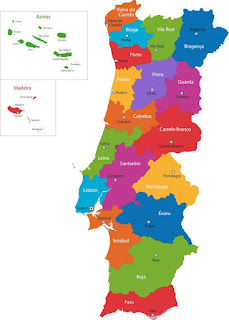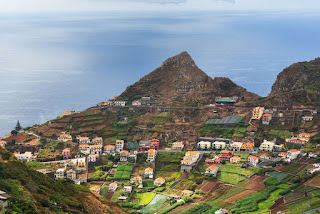 |
| Map of Portugal |
Brief History of Portuguese Wine
Portuguese wine history goes back to at least 2000 BC when vines were cultivated by the Tartessians in the valleys of Tejo and Sado. The Phoenicians arrived to this Iberian Peninsula around the 10th century BC and are known to have cultivated different grape varieties and introduced wine-making techniques. Most of these activities were around the southern part of the Iberian Peninsula. |
| Phoenician colonies marked in yellow in the fourth century BC |
Creation of the Independent Kingdom of Portugal
Portugal was part of the Kingdom of León until 1139 when Dom Afonso Henriques proclaimed himself as the King of Portugal after being victorious in the Battle of Ourique, against a contingent of Moorish forces which governed parts of the Iberian Peninsula.In 1128, Dom Afonso had defeated his own mother Dona Teresa, daughter of the King of León, who had close ties with Galician nobles, which had alarmed Portuguese nobles who were against the prospect of a union with Galicia, and hence, supported Dom Afonso.
In 1143, by the Treaty of Zamora, the Kingdom of León recognized Portugal as an independent kingdom and Afonso I became the first King of Portugal .
Influence of the Cistercian Monks
Of particular importance for the development of viticulture in the Iberian Peninsula were the Benedictine and the Cistercian monks. The Cistercian monks who build monasteries and churches at the base of the fertile hillsides between the Távora and Varosa rivers cultivated vineyards, shared wine-making knowledge with members of its congregations and instilled rules and traditions that benefited the Douro region. |
| Roman Bridge over the river Varosa and surrounding vineyards in Tarouca |
Influence of the British Wine Market
The marriage of King John I from Portugal with Philippa of Lancaster in 1386 created a diplomatic alliance between Portugal and England. The Treaty of Windsor established a pact of mutual support between the two countries which opened the door for trade. Under the terms of the treaty, each country gave the merchants of the other the right to reside in its territory and trade on equal terms with its own subjects. This allowed many English merchants to settle in Portugal and wine was one of the beneficiary of this trade agreement in the long run. |
| Marriage of King John I with Philippa of Lancaster |
The Rapid Growth of Port Wine Production and Export
The second decade of the 18th century was the start of rapid growth in shipments of Port wine and a period of great prosperity for both the producers in the Douro Valley and the Port wine shippers in Porto. The rapid growth also resulted in fraudulent practices and over production as there were no rules or quality control regulations that monitored the wine production. This changed in 1756 when Marquês de Pombal, Portugal’s prime minister established state control over the Port wine trade in the form of a company, the Companhia Geral da Agricultura das Vinhas do Alto Douro also known as the Real Companhia Velha. |
| Companhia Geral da Agricultura das Vinhas do Alto Douro |
By the end of the 18th century, Port wine was exported to many places including the Russian Imperial Court and it represented around 50% of all Portuguese exports.
Double disaster caused by American Plagues Oidium and Phylloxera
The first major disaster to Portuguese viticulture came from a fungus called Oidium which was first noted in Europe in 1845 and later spread to Portugal. Oidium which had previously affected American vineyards, destroyed many Portuguese vineyards and the wine production decreased significantly until a treatment using sulfur was found a few years later.The second biggest disaster for the Portuguese wine industry occurred around 1870 when a severe disease destroyed many of the vineyards in Portugal. The disease was created by the phylloxera pest that is originally native to eastern North America. Phylloxera was inadvertently introduced to Europe by botanists in Victorian England who had collected specimens of American vines in the 1850s.
A brief stop to the destruction was achieved by grafting the European wine-producing vines onto the resistant roots of native American varieties but the destruction caused an economic damage to Portugal and ruined many vineyard owners.
Influence of the European Union
Portugal joined the European Union in 1986 which opened the doors for new investments and liberalized its restrictive wine trade and production practices. |
| Porto, one of the oldest European centers |
Wine Regions of Portugal
The wine regions in Portugal experience a wide variation in soil, traditions and influence of the Atlantic, Mediterranean and even continental climates. Additionally, the difference in orientation of the vineyards, hills, slopes and prevailing winds play an important factor in the micro-climate of the vineyards therefore producing wines of different types and quality across different regions.The soil varies enormously, from granite, slate and schist in the far north to patches of limestone, clay and sand in the south.
The wine regions of Portugal are Douro, Dão, Minho (Vinho Verde), Bairrada, Tavora-Varosa, Trás-os-Montes, Beira Interior, Tejo, Lisboa which are to the north of its capital city Lisbon and Alentejo, Algarve, Setúbal Peninsula, Açores, and Madeira located to the south of Lisbon.
Each of these wine regions and appellations have its own history, and their collective histories make up the history of Portuguese wine.
In this article we explore the main grape varieties and interesting historical facts of five major wine regions of Portugal: Alentejo, Douro, Dão, Lisboa (Lisbon) and Madeira.
Alentejo
Alentejo wine region located in the south-central part of Portugal is a land of sun, open vistas and medieval towns. To the north it borders the left bank of the Tagus river and its name, in Portuguese literally means 'beyond the Tagus'.The region is vast and varied with plains and mountains and the temperature and soil varies across the region with the resulting terroir producing wines having good fruit flavors, complexity, soft tannins and acidity making them a good pairing with food.
 |
| Castelo de Vide, Alentejo |
- The region has a long history of making wine and some ancient methods of wine-making are still preserved in this region—for example the maturation of wine in clay vessels called 'talhas de barro' which were used during the Roman period.
- Alentejo is also home of the Portuguese wine cork industry as cork oak trees grow abundantly in this region.
- Though the region has attracted many new wine producers, most of the wine is produced by 6 co-ops.
The main red grape varieties planted in the Alentejo region are Aragonês (Tempranillo), Trincadeira, Alicante Bouschet and Castelão. The main white grape varieties are Roupeiro and Antão Vaz.
Touriga Nacional, Cabernet Sauvignon and Syrah have been imported to this region. Red grapes are more popular than the floral white grapes.
Douro
The Douro Valley located in the north of Portugal is one of the top wine regions of the world and is a designated UNESCO World Heritage region. The culture and landscape of the Alto Douro signify its long history, traditions and evolution as a wine-making region—terraces, quintas (wine-producing estates), villages, chapels, and roads.Douro is also home of the Port wine which has been Portugal's well known product since the 18th century. Most of the finest vineyards are planted on the steep hillsides bordering the Douro River and its tributaries, such as the Pinhão, the Távora and the Rio Torto. The soil in which the Douro Valley vines are planted is made up of schist, a slate-like metamorphic rock rich in nutrients.
 |
| The vineyards in the Douro Valley |
- Wine has been produced in the Alto Douro region for some 2000 years.
- Between 1757 and 1761 the first comprehensive classification of the Douro Valley was carried out making it the first demarcated and regulated wine region in the world.
- The Upper Douro is considered to be one of the most difficult places where vineyards have been planted and the terraces which were build along the mountainsides to hold up the soil and plant the vines are a testament to the hard work, determination, passion and engineering skills that were required for wine-making in this region.
The main red grape varieties planted in the Douro region are Touriga Nacional, Touriga Franca, Tinto Cão, Tinta Roriz (Tempranillo) and Tinta Barroca. The main white wine grapes planted here are Rabigato, Viosinho and Gouveio.
Dão
Dão named after the river that runs through it is located in the north of Portugal, south of the Douro Valley and its wine-making is centered around its ancient city of Viseu.The region produces a range of grapes and is well known for some of the country's best red wines.
 |
| Viseu city view |
- Dão region has been at the forefront of Portuguese table wine production for many years.
- The biggest name in Dão wine production is Sogrape a pioneer of varietal wines in the region and the largest Portuguese wine producer.
- Most of the vineyards in this region are situated at altitudes between 200-500 meters above sea level, hence getting plenty of sunshine while experiencing cooler night-time temperatures which preserves the acidity levels in the grapes, creating wines with a good balance of fruit flavor, tannins and freshness.
The main red grape varieties planted in the Douro region are Touriga Nacional, Tinta Roriz (Tempranillo), Alfrocheiro Preto and Tinto Cão. Among the white wine varieties planted here Encruzado is considered as one of Portugal's finest white grapes.
Lisboa (Estremadura)
This wine region known as Estremadura until 2008 is a prolific wine region running north from Lisbon along the Atlantic Ocean.The influence of the Atlantic Ocean and the inland terrain of hills and mountain ranges creates a broad terroir and wine with distinct characteristics based on the location of the vineyard and producer.
 |
| Sao Pedro town and santuario do Sr. da Pedra seen from Óbidos |
Interesting Facts
- The region named after the capital city of Portugal is dominated by large co-ops.
- It makes a lot of inexpensive wine known as vinho da mesa (table wine). The region is also know for its sparkling wine which comes from the Óbidos sub-region.
- When compared to other regions of Portugal the grape varieties planted in the Lisboa region have been selected for their high yields and disease resistance rather than the indigenous grapes.
The main red grape varieties planted in the Lisboa region are Castelão and Trincadeira. The main white grape varieties are Fernão Pires, Arinto and Malvasia.
Grape varieties introduced from other regions of Portugal are Touriga Nacional, Touriga Franca and Tinta Roriz. International grapes such as Cabernet Sauvignon, Syrah and Chardonnay are also grown in this region.
Madeira
Madeira is a Portuguese archipelago situated in the north Atlantic Ocean southwest of Lisbon. It is particularly known for its fortified wine.Early exporters of Madeira wines realized that adding a little brandy enabled the wines to survive long journeys. They also found that something extraordinary happened during long, hot sea voyages across the equator—the wine acquired a depth of flavor, softness and a pleasant nutty taste. These wines became known as vinho da roda or wine of the round voyage. Today, most Madeira wine producers use a heating process called Estufagem to produce the wine.
 |
| Madeira |
- The island of Madeira was discovered in 1419 by Portuguese explorers while exploring the coast of West Africa. The island got its name 'Madeira' from the dense woods which were later burnt to create land for cultivation.
- In the 17th up to the 18th century, Madeira wine was considered as a prestigious wine in the colonial Western Hemisphere. Thomas Jefferson used Madeira wine to toast the Declaration of Independence in 1776 and later in 1789, when George Washington was sworn in as the first President of the United States of America, the first inauguration was celebrated with Madeira wine.
- Due to the difficult terrain only about a third of the island is cultivated and nearly all of the growing areas are found on small steep sloped terraces called 'poios' build with stone walls to hold the soil.
The main grape varieties planted in the Madeira region are Tinta Negra Mole, Verdelho, Terrantez, Sercial, Malvasia and Bual.
References
The History of Portugal by James Maxwell Anderson
Oidium or Powdery Mildew of the Vine by Frederic T. Bioletti
The Treaty of Windsor (1386) in a European context by Malcolm Vale
Real Companhia Velha History Document
The World Atlas of Wine
Article Category: Drinks History




No comments